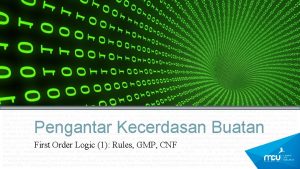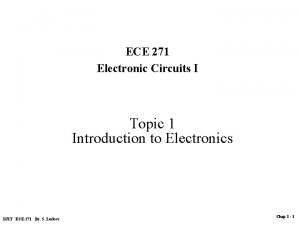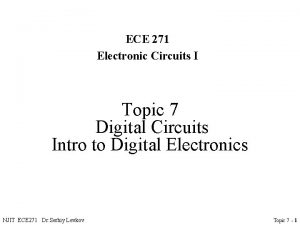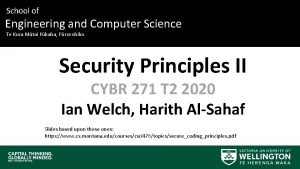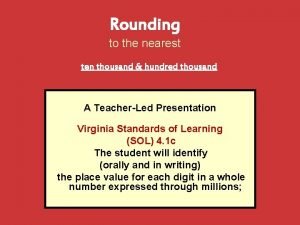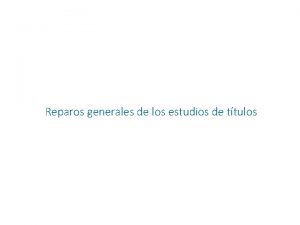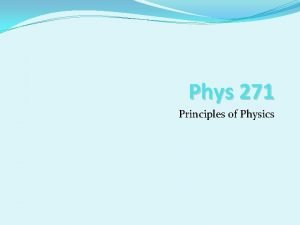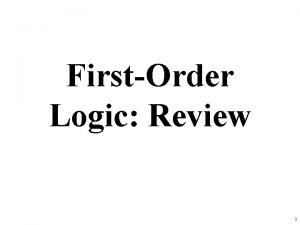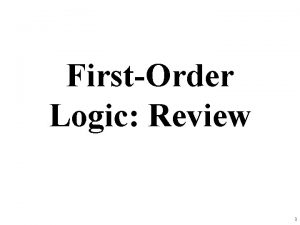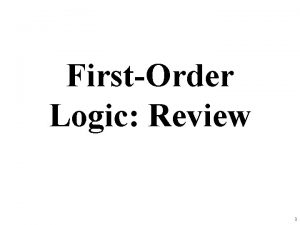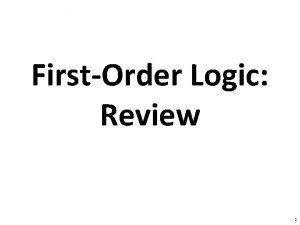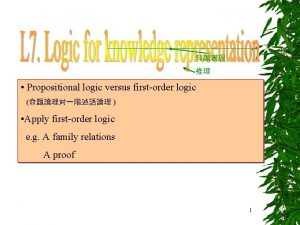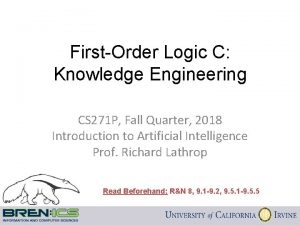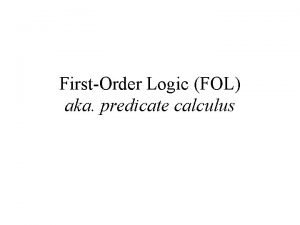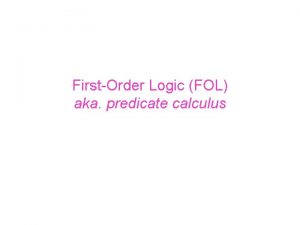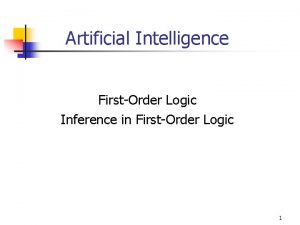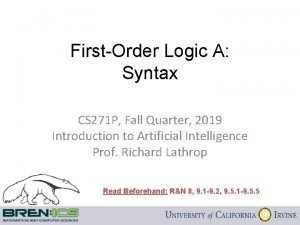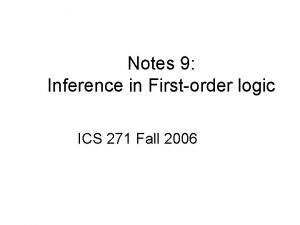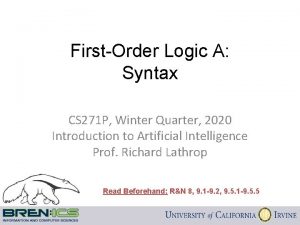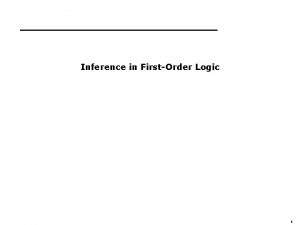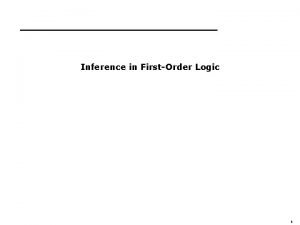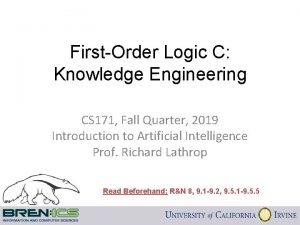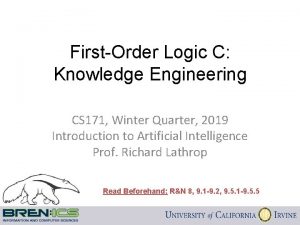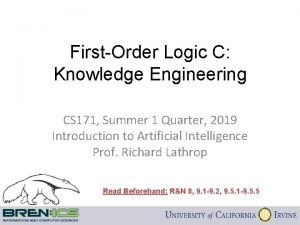FirstOrder Logic C Knowledge Engineering CS 271 P







![FOL Version of Wumpus World • Typical percept sentence: Percept([Stench, Breeze, Glitter, None], 5) FOL Version of Wumpus World • Typical percept sentence: Percept([Stench, Breeze, Glitter, None], 5)](https://slidetodoc.com/presentation_image_h2/0636c8be73abf9e4f85eb53899421995/image-8.jpg)

![Deducing hidden properties Environment definition: x, y, a, b Adjacent([x, y], [a, b]) [a, Deducing hidden properties Environment definition: x, y, a, b Adjacent([x, y], [a, b]) [a,](https://slidetodoc.com/presentation_image_h2/0636c8be73abf9e4f85eb53899421995/image-10.jpg)














- Slides: 24

First-Order Logic C: Knowledge Engineering CS 271 P, Fall Quarter, 2018 Introduction to Artificial Intelligence Prof. Richard Lathrop Read Beforehand: R&N 8, 9. 1 -9. 2, 9. 5. 1 -9. 5. 5

Outline • Review --- Syntactic Ambiguity • Using FOL – Tell, Ask • Example: Wumpus world • Deducing Hidden Properties – Keeping track of change – Describing the results of Actions • Set Theory in First-Order Logic • Knowledge engineering in FOL • The electronic circuits domain

You will be expected to know • Seven steps of Knowledge Engineering (R&N section 8. 4. 1) • Given a simple Knowledge Engineering problem, produce a simple FOL Knowledge Base that solves the problem

Review --- Syntactic Ambiguity • FOPC provides many ways to represent the same thing. • E. g. , “Ball-5 is red. ” – Has. Color(Ball-5, Red) • Ball-5 and Red are objects related by Has. Color. – Red(Ball-5) • Red is a unary predicate applied to the Ball-5 object. – Has. Property(Ball-5, Color, Red) • Ball-5, Color, and Red are objects related by Has. Property. – Color. Of(Ball-5) = Red • Ball-5 and Red are objects, and Color. Of() is a function. – Has. Color(Ball-5(), Red()) • Ball-5() and Red() are functions of zero arguments that both return an object, which objects are related by Has. Color. – … • This can GREATLY confuse a pattern-matching reasoner. – Especially if multiple people collaborate to build the KB, and they all have different representational conventions.

Review --- Syntactic Ambiguity --Partial Solution • FOL can be TOO expressive, can offer TOO MANY choices • Likely confusion, especially for teams of Knowledge Engineers • Different team members can make different representation choices – E. g. , represent “Ball 43 is Red. ” as: • a predicate (= verb)? E. g. , “Red(Ball 43)” ? • an object (= noun)? E. g. , “Red = Color(Ball 43))” ? • a property (= adjective)? E. g. , “Has. Property(Ball 43, Red)” ? • PARTIAL SOLUTION: – An upon-agreed ontology that settles these questions – Ontology = what exists in the world & how it is represented – The Knowledge Engineering teams agrees upon an ontology BEFORE they begin encoding knowledge

Using FOL • We want to TELL things to the KB, e. g. TELL(KB, x King(x) Person. X) ) TELL(KB, King(John) ) These sentences are assertions • We also want to ASK things to the KB, ASK(KB, x Person(x) ) these are queries or goals The KB should return the list of x’s for which Person(x) is true: {x/John, x/Richard, . . . }

Knowledge engineering in FOL 1. Identify the task 2. Assemble the relevant knowledge 3. Decide on a vocabulary of predicates, functions, and constants 4. Encode general knowledge about the domain 5. Encode a description of the specific problem instance 6. Pose queries to the inference procedure and get answers 7. Debug the knowledge base
![FOL Version of Wumpus World Typical percept sentence PerceptStench Breeze Glitter None 5 FOL Version of Wumpus World • Typical percept sentence: Percept([Stench, Breeze, Glitter, None], 5)](https://slidetodoc.com/presentation_image_h2/0636c8be73abf9e4f85eb53899421995/image-8.jpg)
FOL Version of Wumpus World • Typical percept sentence: Percept([Stench, Breeze, Glitter, None], 5) • Actions: Turn(Right), Turn(Left), Forward, Shoot, Grab, Release, Climb • To determine best action, construct query: a Best. Action(a, 5) • ASK solves this and returns {a/Grab} – And TELL about the action.

Knowledge Base for Wumpus World • Perception – s, g, x, y, t Percept([s, Breeze, g, x, y], t) Breeze(t) – s, b, x, y, t Percept([s, b, Glitter, x, y], t) Glitter(t) • Reflex action – t Glitter(t) Best. Action(Grab, t) • Reflex action with internal state – t Glitter(t) Holding(Gold, t) Best. Action(Grab, t) Holding(Gold, t) can not be observed: keep track of change.
![Deducing hidden properties Environment definition x y a b Adjacentx y a b a Deducing hidden properties Environment definition: x, y, a, b Adjacent([x, y], [a, b]) [a,](https://slidetodoc.com/presentation_image_h2/0636c8be73abf9e4f85eb53899421995/image-10.jpg)
Deducing hidden properties Environment definition: x, y, a, b Adjacent([x, y], [a, b]) [a, b] {[x+1, y], [x-1, y], [x, y+1], [x, y-1]} Properties of locations: s, t At(Agent, s, t) Breeze(t) Breezy(s) Squares are breezy near a pit: – Diagnostic rule---infer cause from effect s Breezy(s) r Adjacent(r, s) Pit(r) – Causal rule---infer effect from cause (model based reasoning) r Pit(r) [ s Adjacent(r, s) Breezy(s)]


Yale shooting problem • The Yale shooting problem illustrates the frame problem. (Its inventors were working at Yale University when they proposed it. ) • Fred (a turkey) is initially alive and a gun is initially unloaded. Loading the gun, waiting for a moment, and then shooting the gun at Fred is expected to kill Fred. • However, in one solution, Fred indeed dies; in another (also logically correct) solution, the gun becomes mysteriously unloaded and Fred survives. • By Hanks and Mc. Dermott, adapted from Wikipedia



Set Theory in First-Order Logic Can we define set theory using FOL? - individual sets, union, intersection, etc Answer is yes. Basics: - empty set = constant = { } - unary predicate Set( ), true for sets - binary predicates: x s (true if x is a member of the set s) s 1 s 2 (true if s 1 is a subset of s 2) - binary functions: intersection s 1 s 2, union s 1 s 2 , adjoining {x|s}

A Possible Set of FOL Axioms for Set Theory The only sets are the empty set and sets made by adjoining an element to a set s Set(s) (s = {} ) ( x, s 2 Set(s 2) s = {x|s 2}) The empty set has no elements adjoined to it x, s {x|s} = {} Adjoining an element already in the set has no effect x, s x s s = {x|s} The only elements of a set are those that were adjoined into it. Expressed recursively: x, s x s [ y, s 2 (s = {y|s 2} (x = y x s 2))]

A Possible Set of FOL Axioms for Set Theory A set is a subset of another set iff all the first set’s members are members of the 2 nd set s 1, s 2 s 1 s 2 ( x x s 1 x s 2) Two sets are equal iff each is a subset of the other s 1, s 2 (s 1 = s 2) (s 1 s 2 s 1) An object is in the intersection of 2 sets only if a member of both x, s 1, s 2 x (s 1 s 2) (x s 1 x s 2) An object is in the union of 2 sets only if a member of either x, s 1, s 2 x (s 1 s 2) (x s 1 x s 2)

The electronic circuits domain One-bit full adder Possible queries: - does the circuit function properly? - what gates are connected to the first input terminal? - what would happen if one of the gates is broken? and so on

The electronic circuits domain 1. Identify the task – Does the circuit actually add properly? 2. Assemble the relevant knowledge – Composed of wires and gates; Types of gates (AND, OR, XOR, NOT) – Irrelevant: size, shape, color, cost of gates 3. Decide on a vocabulary – Many alternative ways to say X 1 is an OR gate: – Type(X 1) = XOR (function) Type(X 1, XOR) (binary predicate) XOR(X 1) (unary predicate) etc.

The electronic circuits domain 4. Encode general knowledge of the domain – t 1, t 2 Connected(t 1, t 2) Signal(t 1) = Signal(t 2) – t Signal(t) = 1 Signal(t) = 0 – 1≠ 0 – t 1, t 2 Connected(t 1, t 2) Connected(t 2, t 1) – g Type(g) = OR Signal(Out(1, g)) = 1 n Signal(In(n, g)) = 1 – g Type(g) = AND Signal(Out(1, g)) = 0 n Signal(In(n, g)) = 0 – g Type(g) = XOR Signal(Out(1, g)) = 1 Signal(In(1, g)) ≠ Signal(In(2, g)) – g Type(g) = NOT Signal(Out(1, g)) ≠ Signal(In(1, g))

The electronic circuits domain 5. Encode the specific problem instance Type(X 1) = XOR Type(A 1) = AND Type(O 1) = OR Connected(Out(1, X 1), In(1, X 2)) Connected(Out(1, X 1), In(2, A 2)) Connected(Out(1, A 2), In(1, O 1)) Connected(Out(1, A 1), In(2, O 1)) Connected(Out(1, X 2), Out(1, C 1)) Connected(Out(1, O 1), Out(2, C 1)) Type(X 2) = XOR Type(A 2) = AND Connected(In(1, C 1), In(1, X 1)) Connected(In(1, C 1), In(1, A 1)) Connected(In(2, C 1), In(2, X 1)) Connected(In(2, C 1), In(2, A 1)) Connected(In(3, C 1), In(2, X 2)) Connected(In(3, C 1), In(1, A 2))

The electronic circuits domain 6. Pose queries to the inference procedure: What are the possible sets of values of all the terminals for the adder circuit? i 1, i 2, i 3, o 1, o 2 Signal(In(1, C 1)) = i 1 Signal(In(2, C 1)) = i 2 Signal(In(3, C 1)) = i 3 Signal(Out(1, C 1)) = o 1 Signal(Out(2, C 1)) = o 2 7. Debug the knowledge base May have omitted assertions like 1 ≠ 0

Review --- Knowledge engineering in FOL 1. Identify the task 2. Assemble the relevant knowledge 3. Decide on a vocabulary of predicates, functions, and constants 4. Encode general knowledge about the domain 5. Encode a description of the specific problem instance 6. Pose queries to the inference procedure and get answers 7. Debug the knowledge base

Summary • First-order logic: – Much more expressive than propositional logic – Allows objects and relations as semantic primitives – Universal and existential quantifiers – syntax: constants, functions, predicates, equality, quantifiers • Knowledge engineering using FOL – Capturing domain knowledge in logical form
 Knowledge engineering in first order logic
Knowledge engineering in first order logic Round off to the nearest ten thousands
Round off to the nearest ten thousands Kcl theory
Kcl theory 254 en yakın onluğa yuvarlama
254 en yakın onluğa yuvarlama Pseudo nmos logic ppt
Pseudo nmos logic ppt Cybr 271
Cybr 271 Round 625 to the nearest hundred
Round 625 to the nearest hundred Ddu 271
Ddu 271 Phys 271
Phys 271 271 21
271 21 First order logic vs propositional logic
First order logic vs propositional logic First order logic vs propositional logic
First order logic vs propositional logic Third order logic
Third order logic Combinational logic vs sequential logic
Combinational logic vs sequential logic Tw
Tw Combinational logic sequential logic 차이
Combinational logic sequential logic 차이 Combinational logic sequential logic
Combinational logic sequential logic Combinational logic sequential logic 차이
Combinational logic sequential logic 차이 Combinational logic sequential logic
Combinational logic sequential logic Shared and personal knowledge
Shared and personal knowledge Knowledge shared is knowledge squared meaning
Knowledge shared is knowledge squared meaning Knowledge shared is knowledge multiplied meaning
Knowledge shared is knowledge multiplied meaning Knowledge creation and knowledge architecture
Knowledge creation and knowledge architecture Contoh shallow knowledge dan deep knowledge
Contoh shallow knowledge dan deep knowledge A priori knowledge
A priori knowledge
